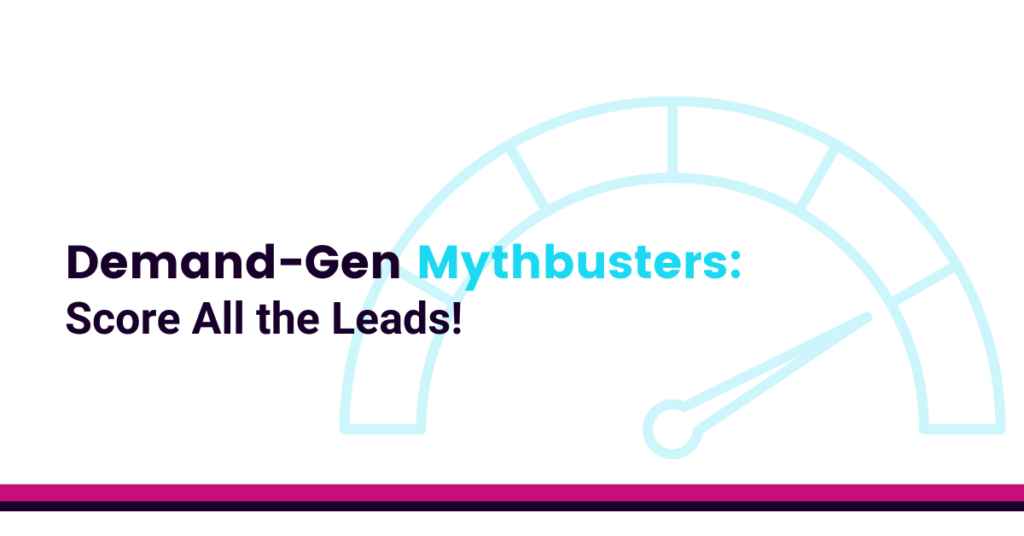

To score all the leads, or not to score all the leads...
If there’s something weird,
and it don’t look good
Who you gonna call?
Mythbusters!
I have been in a lot of conversations lately about lead scoring. Typically it starts with people trying to understand their conversion rates at the top of the funnel or with BDR capacity planning. And, I have to say, it feels like one of those things we do because it’s the thing we’ve always done, instead of taking a step back to understand – is this adding value? Or should I Marie Kondo this out of my life?
Welcome to our first topic in: Demand-Gen Mythbusters. Where we’ll tackle common myths about demand-gen and set the record straight for early stage startups. Today – we bust the myth that lead scoring is a necessity for demand-gen teams.
First, let’s get on the same page:
Lead Scoring
The process of assigning a value to each lead that gets generated. This value is determined by a set of criteria that indicate which leads are most likely to convert to paying customers. The end result is a prioritized list of leads for sales to follow up on.
How is the score determined?
A lead is assigned a value based on your pre-defined criteria for things that equate to intent. An example score may be made up of:
- Industry
- Persona
- Segment
- Type of interaction (demo request, content download, webinar attendee, etc.)
- Number of interactions
- etc.
What’s the end result?
You may determine that any lead with a score of 4 or higher needs to be followed up on within 24 hours. Any lead with a score of 2 or 3 requires sales follow-up next. And, anything that scores a 1 does not get followed up on and instead gets put into a marketing nurture stream until it scores more points.
In the end, you have a whittled down and prioritized list of leads for sales with distinct SLA’s tied to each range of scores.
But, is it worth it?
The myth here is of course that every demand-gen team should be doing lead scoring. More data is always better, right? And if we have a way of signaling to sales that there’s a hot lead, then why wouldn’t we do it?
We don’t entirely disagree. But before you get all lead score happy, consider these 3 questions:
- Where are you in your demand-gen maturity?
- What does your lead to BDR ratio look like?
- What does your database look like?
Demand-gen maturity. Are you at an early stage startup and just launching demand-gen, or have you been doing this for a while and are a well oiled machine? If you’re on the newer side, you may have a good hypothesis about what constitutes a good lead, but you need time to prove it out. Ask yourself if you know for sure how these scores should be set, or if you should take a bit more of an experimental approach by following up with all leads in a timely manner.
BDR capacity. Are you generating way more leads than your current BDR team can process? If so, please take a moment to give us a virtual high-five. Nice work. But if, like most of us, that isn’t the case and you either have the right amount of leads flowing in for your current BDR’s, or are below full capacity, then your BDR’s should be following up on every lead. You can help educate them on which leads may be “hotter” than others – i.e. maybe don’t make someone who raised their hand for a demo request wait while you follow up on content syndication leads – but you don’t need to score your way to common sense.
Quick sidebar on BDR capacity. Recently, we did a discovery session with a client where we examined their funnel in detail. We noticed a lower-than-normal conversion rate from lead-to-MQL and started asking questions. Turns out, they had some really tight lead scoring in place that made it difficult for a lead to make it to MQL to trigger BDR follow-up. When we started asking questions about BDR capacity, it turned out the BDR didn’t have enough leads to follow up on and instead was resorting to cold outbound outreach to fill their time. We suggested they loosen their lead scoring a bit to allow their BDR to follow-up on actual leads in the database that were sitting there untouched because they hadn’t met their tight criteria yet. In the end, it worked. The BDR had warmer leads to follow-up on and spent fewer cycles on cold outreach.
Database size. Do you have an enormous database of leads that need to be revisited? Maybe they were generated before you had the processes in place to properly follow-up, they fell through the cracks with sales or they came in before a team was even in place to process them? In this case, scoring could be a really good way to point BDR’s towards leads to try to re-heat vs. leads that marketing will send through nurture to try to re-engage. But, again, if you’re still building your database and every lead is precious, there is no need to score your way out of an at-bat for the sales team.
Because, that’s the thing. Every sales cadence, every cold call, every LinkedIn reachout teaches sales and marketing something, especially in those early days. Even if the lead isn’t perfect, your BDR had one more opportunity to practice their pitch.
So unless it’s literally raining leads, let’s leave lead scoring on the “to be evaluated again later” list.
Consider this myth officially busted.

We’d love to connect!
Interested in trying the 4AM Platform for free? Create an account and let us know what you think!


